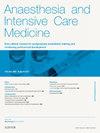Anaesthesia for open abdominal aortic surgery
IF 0.3
Q4 ANESTHESIOLOGY
引用次数: 0
Abstract
The prevalence of abdominal aortic aneurysm (AAA) has declined in recent years and according to the annual National Vascular Registry reports (2019–23) the number of patients undergoing aneurysm repair has been steadily decreasing over the last 5 years. The UK has worked tirelessly to reduce its operative mortality rates for elective open AAA repair with the introduction of a quality improvement pro-gramme. Reducing death from ruptured aortic aneurysm has been the focus of the national screening programme. The short-term benefits of endovascular aneurysm repair (EVAR) when compared to open repair are well described, however, the long-term survival benefits, freedom form re-intervention and cost effectiveness of EVAR have been demonstrated to be dominated by open surgery. That is that people with intact AAA should be offered open surgery if medically suitable. The choice of technique for emergency AAA repair is less contentious, with the more traditional approach of open repair being rapidly overtaken by endovascular options in those who are anatomically suitable for EVAR. Technical analysis by the National Institute for Health and Care Excellence has consistently reported favourable outcomes with EVAR in the emergency setting and that it is a cost-effective treatment. In this article we provide an overview of the evidence supporting the different treatment options, outline current approaches to risk stratification, describe the key physiological changes that occur during open repair and describe an overview of the approach to perioperative management.
腹主动脉切开手术麻醉
近年来,腹主动脉瘤(AAA)的患病率有所下降,根据年度国家血管登记报告(2019-23),在过去5年里,接受动脉瘤修复的患者数量一直在稳步下降。英国一直在不懈努力,通过引入质量改进方案来降低选择性开放式AAA修补术的手术死亡率。减少主动脉瘤破裂造成的死亡一直是国家筛查方案的重点。与开放式修复相比,血管内动脉瘤修复(EVAR)的短期益处已被很好地描述,然而,EVAR的长期生存益处、免于再干预和成本效益已被证明以开放式手术为主。也就是说,如果医学上合适,AAA完好的人应该接受开放手术。急诊AAA修复技术的选择争议较少,在解剖上适合EVAR的患者中,更传统的开放修复方法正迅速被血管内修复方法所取代。国家卫生和保健卓越研究所的技术分析一致报告了在紧急情况下EVAR的有利结果,并且这是一种具有成本效益的治疗方法。在本文中,我们概述了支持不同治疗方案的证据,概述了目前的风险分层方法,描述了开放修复过程中发生的关键生理变化,并概述了围手术期管理方法。
本文章由计算机程序翻译,如有差异,请以英文原文为准。
求助全文
约1分钟内获得全文
求助全文
来源期刊

Anaesthesia and Intensive Care Medicine
ANESTHESIOLOGY-
CiteScore
0.50
自引率
0.00%
发文量
152
期刊介绍:
Anaesthesia and Intensive Care Medicine, an invaluable source of up-to-date information, with the curriculum of both the Primary and Final FRCA examinations covered over a three-year cycle. Published monthly this ever-updating text book will be an invaluable source for both trainee and experienced anaesthetists. The enthusiastic editorial board, under the guidance of two eminent and experienced series editors, ensures Anaesthesia and Intensive Care Medicine covers all the key topics in a comprehensive and authoritative manner. Articles now include learning objectives and eash issue features MCQs, facilitating self-directed learning and enabling readers at all levels to test their knowledge. Each issue is divided between basic scientific and clinical sections. The basic science articles include anatomy, physiology, pharmacology, physics and clinical measurement, while the clinical sections cover anaesthetic agents and techniques, assessment and perioperative management. Further sections cover audit, trials, statistics, ethical and legal medicine, and the management of acute and chronic pain.
 求助内容:
求助内容: 应助结果提醒方式:
应助结果提醒方式:


